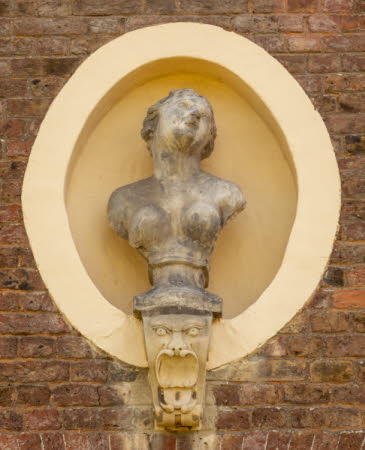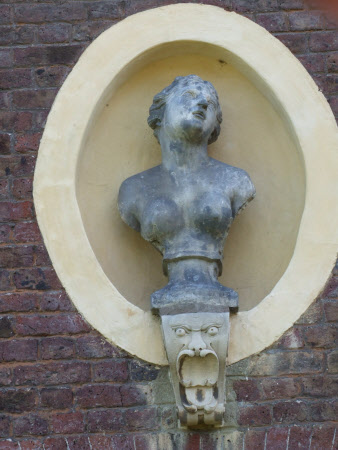Portrait bust of Cleopatra, Queen of Egypt
workshop of John Besnier (fl.1681)
Category
Art / Sculpture
Date
c. 1670 - 1672
Materials
Lead, Sandstone
Place of origin
London
Order this imageCollection
Ham House, Surrey
NT 1140359
Summary
A lead portrait bust of Cleopatra, queen of Egypt, naked and with her breasts exposed. One of thirty-eight lead busts made for the garden walls of Ham House in 1671-72, perhaps in the workshop of John Besnier, thirty-six of which survive in niches on the walls and on the north façade of the house.
Full description
A lead portrait bust of Cleopatra, queen of Egypt (69-30 B.C.), shown naked and with her breasts exposed. Her head is turned upwards and to her left, her hair parted at the middle and gathered up at the back. Mounted on a plinth, and placed on a sandstone console decorated with a snarling animal mask. One of thirty-six lead busts displayed in oval niches in the garden walls and on the north façade of Ham House, probably installed in 1671-72, and recorded in the 1679 inventory of Ham House. The entire series was probably arranged in its present positions along the garden walls and on the north front of Ham House by the 6th Earl of Dysart, as part of improvements undertaken between 1798 and 1803. Although the majority of the busts are portraits of male subjects, these are complemented by a series of female busts, almost all of which are displayed on the north front of Ham House. Some may depict the consorts of Roman Emperors or other Classical heroines, such as Cleopatra in this bust. The bust in his case is derived from a modern source in the collection of King Charles I, a full-size bronze standing figure of Cleopatra in the Royal Collection (RCIN 39714), cast in 1636 by Charles I’s sculptor Hubert Le Sueur (c. 1580-1658) and itself cast from a late sixteenth-century marble statue, now in the Musée du Louvre, Paris. Le Sueur is also known to have made for Charles I a bust in bronze of Cleopatra, which was sold during the Commonwealth sales and is now lost (Charles Avery, 'Hubert Le Sueur, the 'unworthy Praxiteles' of King Charles I', The Walpole Society, Vol. 48 (1980-82), pp. 135-209, p. 180, no. 25). The lead busts may well, like other sculpture at Ham House, have been made in the workshops of the Besnier family, perhaps by John Besnier, who received a commission for lead statuary from the Duke of Ormonde in 1681. For a fuller discussion of the garden wall busts and their history and attribution, see NT 1140333. Jeremy WarrenJanuary 2022
Provenance
Probably made and installed in 1671-72, to the commission of John Maitland and Elizabeth Murray, 1st Duke and Duchess of Lauderdale. Thence by descent,until acquired in 1948 by HM Government when Sir Lyonel, 4th Bt (1854 – 1952) and Sir Cecil Tollemache, 5th Bt (1886 – 1969) presented Ham House to the National Trust. Entrusted to the care of the Victoria & Albert Museum until 1990, when returned to the care of the National Trust, to which ownership was transferred in 2002.
Makers and roles
workshop of John Besnier (fl.1681), sculptor
References
Avery 2013: Charles Avery, ‘Seventeenth-century Sculpture at Ham House’ in Christopher Rowell, ed., Ham House. 400 Years of History, New Haven/London 2013, pp. 158-77., pp. 172-76, fig. 162 (incorrectly captioned as NT 1140357).


